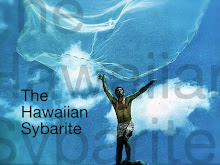
photo © Daniel Groom
One of The Hawaiian Sybarite's favourite anarchists, Dame Vivienne Westwood, has partered with Cole & Son, royal warrant holder and official purveyor of wallpaper to Her Majesty The Queen, to release a hand-printed collection of wallpapers based on Westwood's textile designs.
In 2000, Vivienne Westwood moved from the council estate in Clapham, London where she had lived for 30 years into a Queen Anne style house built in 1703, which once belonged to the mother of Hawaiʻi's most famous stabbing-victim, Captain James Cook.
Perhaps the blank walls and architectural details of her new home in the Queen Anne style—18th century English Baroque—piqued Westwood's interest in period wallpapers. Whatever the impetus for the collaboration between her and Cole & Son, we like the result.

photo © 2010 Cole & Son (Wallpapers) Ltd. All rights reserved.
"It is good when my ideas get carried over into other artistic media. This collection is a perfect opportunity to be able to work with a heritage company like Cole & Son and to see my ideas from fashion translated into the world of interiors and wallpaper," Westwood told Women's Wear Daily.

photo © 2010 Cole & Son (Wallpapers) Ltd. All rights reserved.
The Vivienne Westwood for Cole & Son wallpapers are taken directly from her fashion textiles. An exquisitely detailed trompe-l'oeil tartan print is straight from the designer's iconic plaid runway looks, the "Cut-Out Lace" print is taken from her Spring-Summer 2007 "I am Expensiv" collection, and our favorite wallpaper of the selection,"Squiggle," is based on a pattern that was originally created for the "Pirate" collection of Autumn-Winter 1981.

photo © 2010 Cole & Son (Wallpapers) Ltd. All rights reserved.
Cole & Son have designed and printed wallpaper collections and bespoke designs since 1875, and are the only company in the world to use the original method for hand flocking wallpaper to imitate silk velvet, and are also now one of the last two traditional hand block printers remaining in the world. The company's archive holds approximately 1,800 block print designs, 350 screenprint designs and a huge cache of original drawings and wallpapers representing styles from the 18th century to the present, and a bespoke service is offered for the designs, as well as for custom colorways and hand gilding.

photo © 2010 Cole & Son (Wallpapers) Ltd. All rights reserved.
We appreciate Cole & Son for its elegant use of traditional handcraft while at the same time employing new machine printing technology, advanced papers, metallic links, lustres and foils together with patterns by some of the designers that we like the most, such as Tom Dixon, David Hicks and the iconic Italian artist Piero Fornasetti.
And now, you can add Vivienne Westwood to that list.

photo © 2010 Cole & Son (Wallpapers) Ltd. All rights reserved.
The Vivienne Westwood for Cole & Son wallpapers dont come cheap, with prices ranging from £55 to £200 (roughly US $80 to $300), but if you are undeterred, the collection is available in North America from Walnut Wallpaper & Trim Shop, 7424 Beverly Boulevard, Los Angeles, California, USA 90036-2725, (323) 932-9166 and from Lee Jofa, 101 Henry Adams Street, Suite 490, San Francisco, California, USA 94103-5223, (415) 626-6921.













































